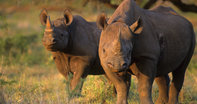
Name
Black rhinoceros (Diceros bincornis sp). There are four subspecies in Africa namely the southern central black rhino (Diceros bicornis minor); eastern black rhino (Diceros bicornis michaeli); southwestern black rhino (Diceros bicornis bicornis) and the western black rhino (Diceros bicornis longipes). The western black rhino was declared extinct in 2011, and the black rhino species overall is under threat of poaching.Appearance
The appearance of the black rhino can be described by distinguishing it from the white rhino species, most distinctly by the shape of its upper lip, head, and shape of its ears.
The black rhino has a pointed upper lip, a head held high for browsing (smaller than the white rhino), with rounded, cone-shaped ears.
The black rhino is smaller than the white, with bulls weighing up to 1200 kg and cows weighing approximately 800 kg. The black rhino is actually light grey of colour, but their skins are coated and coloured by the soil and mud in which they like to roll.
Black Rhino Diet
The black rhino is a browser, feeding on trees and higher bushes. With its curved upper lip, it hooks branches and twigs into its mouth, shears the food with its molars and chews. Only when suffering from nutritional stress, will black rhino will eat grass. In the bush, it is noticeable where it has browsed by branches and bushes cut at an angle.Black Rhino Breeding
Black rhino cows give birth for the first time when they are 5 or 6 years of age. They have no specific breeding season. Bulls butt cows with their horns in courtship and mating can be a rather violent and protracted occurrence.Black Rhino Behaviour
Black rhino males are solitary and territorial and determine the size of their territories according to food and water supply. Bulls may kill younger bulls wandering into their area of land.
Only during the cow’s oestrus cycle, will the bull move closer and can spend about 30 days with the cow. The black rhino sometimes covers the dunghills of the white rhino with its own dung. It can run up to 55 km/h.
Where They are Found
The majority of black rhinos are found in South Africa, Namibia, Zimbabwe, and Kenya. The species is under great threat, with the population having drastically declined from about 65 000 in 1970 to 2400 in 1995.
Small populations of the Southwestern black rhino are being developed, and a trans-located population of the eastern black rhino is established in the Addo Elephant National Park in South Africa.
Field Notes
Rhino horn has become a commodity valued more than cocaine. The trade in rhino horn has increased exponentially, posing an even greater threat to the rhinos of Africa.
Rhino horn has been an ingredient to traditional Chinese medicine for thousands of years, falsely believed to treat various ailments from epilepsy to fevers.
It has been traded and exported to numerous Asian countries for medicinal uses, and Yemen to be used as jambiya dagger handles. Conservation efforts are in place to help reduce rhino poaching and to protect the black rhinos of South Africa.
 By far the most tragic issue facing the Kruger (and many other conservation areas across Africa) is the dramatic increase in rhino poaching ...
By far the most tragic issue facing the Kruger (and many other conservation areas across Africa) is the dramatic increase in rhino poaching ...